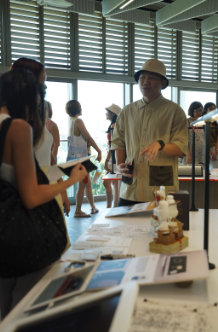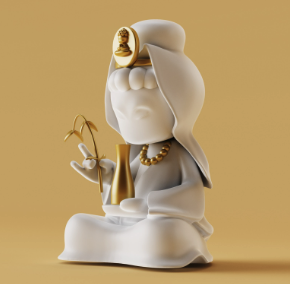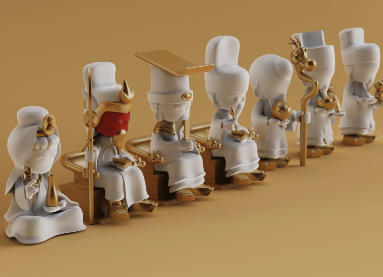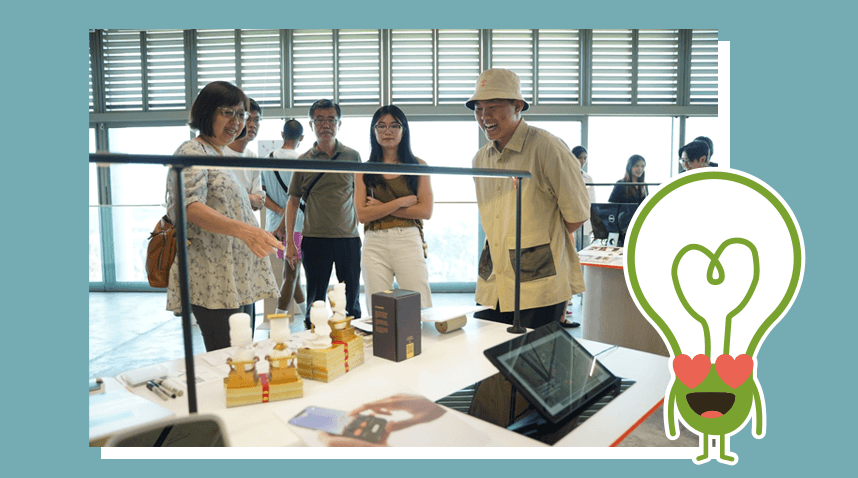Would you add a Buddhist altar to your new home?
For many young folks, it might sound a bit old-fashioned, like trying to fit a square peg into a round hole in your modern living room.
Buddhism is the second largest religion in the Southeast Asia region, and having a Buddhist altar at home is kind of a tradition. It’s where generations gather to pray, carrying on a practice that’s been around for ages. But recently, something’s been changing.
More and more young people are saying, “Thanks, but no thanks” to this tradition. They find it a bit tricky to mix old practices with their modern lifestyle.
Meet Donaven. A student of product design, during his final year project, took on a pretty hefty challenge: the modernisation of altars. His mission? To build a bridge between the past and today through design, and making deities in Taoism and Buddhism relatable to the younger generation.

Why have Buddhist Figures?
Take a closer look at Buddhist statues like the peaceful Buddha or the kind-hearted Goddess of Mercy. You’ll notice something interesting—they’ve changed a lot over time. A Buddha statue in China might look different from one in Sri Lanka. Some might not even look human!
This variety shows how Buddhism can adapt to different cultures and artistic styles. After all, the Buddha isn’t around anymore to say how he should look.

Cr: Buddho.org
Now, here’s a cool fact: When the Buddha was alive, he didn’t say, “Hey, make some statues of me!” Instead, he used simple but powerful symbols to remind people of his teachings. One was the Bodhi Tree, which stood for the quest for enlightenment.
The other was a pair of footprints, representing the path to spiritual awakening. It took many years after the Buddha’s time for people to start making statues of him. The Greeks were purportedly the first to make statues of Buddha (some say it was in the likeness of Apollo).
During the Buddha’s era, there was also no mention of specific offerings or elaborate altar setups for worship.
But maybe there’s something human in us that needs a tangible figure to connect with a teacher’s wisdom and qualities. The tradition of offering items, which faithful devotees initiated as a means to remind themselves of these teachings (like the symbolic flowers representing impermanence), also underscores this very human need. With that in mind, perhaps it is time for these statues to change their style to click with new generations.
Project Makeover

Donaven’s project is all about this evolution. He has taken ancient figures like the Goddess of Mercy and given them a makeover to make them fit seamlessly into modern homes.
Donaven shared his inspiration: “Growing up, my parents prayed every day at our family altar. But no one really explained who these deities were or why we did it. I wondered if my generation would carry on these practices or if the deities would become distant figures. That got me thinking.”
He conducted research and interviews, finding a big gap between the younger generation and these ancient deities. “The problem was, young people didn’t understand or relate to these figures. So, I decided to change that,” he says.
Donaven’s mission goes beyond creating aesthetically pleasing statues. It’s about reigniting a connection with these age-old figures, reminding us of the qualities they embody and the values they hold in our modern lives.
The revamped figures gave these deities a contemporary twist while preserving their profound meanings.
For instance, his modern Goddess of Mercy statue, with its minimalistic design, still retains essential symbols like the vase and the willow branch, representing compassion and healing.
Furthermore, Donaven’s project extends into the digital realm. He’s created an interactive online platform packed with curated information about the deities.
Here, you can understand the meaning behind various depictions of characters, like Kwan Yin with a thousand arms or in a half-seated posture, and explore the symbolism behind the objects they commonly hold.
This platform is accessible to the public, offering an opportunity to delve into and learn about these rich traditions from the comfort of our modern, connected world.
Challenges in modernisation:
Donaven’s journey was not without its challenges. Respect for Guan Yin transcends Buddhism and extends into other religions like Taoism. Different craftsmen have their interpretations of the deity’s appearance, which meant Donaven had to consult experts and compare with several models to ensure he captured the essence correctly.
Another challenge was striking the right balance between tradition and pop culture. While modernisation was essential, the essence of tradition couldn’t be lost in the process.
Donaven had to ensure the modernised Guan Yin retained its sacred significance.
The project’s initial goal was to give a modern facelift to entire altars, aiming to bridge the generational gap. However, a significant barrier emerged—what makes a respectable Buddhist statue wasn’t just about aesthetics but also capturing the spiritual essence of the deity it represents.
Many who saw the remodelled versions found themselves questioning, “Can I really bow down to this adorable-looking statue?” Additionally, there were numerous considerations about the items and features that would go into a complete altar setup.

How can he introduce change without offending devout Buddhists or without seeming disrespectful towards their culture?
Recognising these challenges, Donaven decided to pivot the project’s focus towards creating collectables that would ignite conversations. Instead of overhauling entire altars, the new approach aimed to spark curiosity among the younger generation about these ancient figures.
Picture having a collection of deity figurines showcased in your contemporary home. This could captivate the interest of your guests, prompting them to inquire about the significance of the designs and delve into the symbolism. It serves as a gateway to not only learning about the teachings but also fostering a deeper understanding of them.
For Donaven, the ability to strike a delicate balance is the greatest highlight of this project: Paying homage to the rich cultural heritage and symbolism of the deities while ensuring their resonance with the younger generation.
Advancing beyond the confines of his Final Year Project, Donaven envisions turning his mission into reality by establishing a company dedicated to crafting figurines inspired by the traditions of Taoism and Buddhism.
What matters in the end

So would you or should you have an altar at your new home?
In the grand scheme of things, the practice of Buddhism is inherently inward-looking. Statues and objects of veneration play a vital role in inspiring faith and serving as reminders of the path to enlightenment.
Yet, they are but stepping stones on a much more profound journey.
It’s crucial to understand that mere devotion and prayer won’t bring about salvation or free us from the shackles of dissatisfaction. The heart of Buddhism lies in the application of its teachings.
This was highlighted in the Paccha-bhumika Sutta. Just like no amount of prayer can make the boulder float to shore, mere prayers and circumambulation, while sincere, cannot alter the consequences of harmful deeds. On the contrary, a person who leads a life of virtue, refraining from harm and cultivating wisdom, is destined for a good destination, even if others pray for a different outcome.
So, while statues and altars serve as valuable reminders, it’s in the practice of these principles that we truly unlock the transformative power of Buddhism.
It’s the journey within ourselves, the conscious effort to live virtuously, cultivate a concentrated mind, and seek wisdom that paves the way to liberation and lasting peace.
However, if you still prefer a tangible object to inspire your practice, you can consider acquiring one of Donaven’s thoughtfully designed figurines or explore the following recommended shops:


